Steps To Getting Your License Reinstated

No matter the reason for the suspension, we all have one thing in common—the need to reinstate your driver’s license in the shortest time possible. Every one of us relies on our car for everything. Getting to work, getting food, and going out to have fun are just a few of the multitudes of activities that each of us utilizes our cars for. Because of this, when we lose our license and cannot drive our car, our lives are essentially put on hold. Even so, just because you have had your license revoked does not mean your hopes for driving are over. Depending on why you lost your license in the first place, there is probably a way to regain your driving privileges. Here are the steps to getting your license reinstated after it has been revoked.
What Causes Most People To Lose Their License
Before we talk about how to regain your license, it would be remiss not to discuss what actions can lead to your license being taken away in the first place. Most often, people find their license being taken away due to points on their license exceeding five. Even so, there are many ways to get your license suspended. Below we have listed the most common reasons why a license gets suspended.
- Conviction for driving under the influence (DUI)
- Not reporting an accident
- Underage alcohol consumption
- Not having auto insurance
- Refusal of drug or alcohol test
- Too many points on your driving record
- Failing to show up to a court hearing
- Failing to pay child support
- Habitual offense (repeating the same traffic violation)
- Felony involving a motor vehicle
- Hit and run charge
- Vehicular manslaughter conviction
- Fleeing and evading police
Out of the situations listed above, serious offenses such as refusal of drug test or a DUI conviction lead to an immediate license suspension, while other less serious offenses like habitual offenses take some time and effort on the part of the driver to accrue.
How a Suspended License Affects You
In general, the main reason why most licenses are revoked is due to having too many points on a driving record. Many do not realize that from the moment one receives their license, their driving record starts. What’s more, the points that you do accrue on your record often stick around for a specified number of years before they can be struck from your record.
Outside of legal ramifications, a suspended license can significantly affect your professional and personal life. Based on the offense that caused you to lose your license in the first place, many places of work may turn you down for a job solely based on your driving record.
Along with a lost suspension, one can expect drastically higher insurance rates once you do manage to reinstate your license. In some cases, it may never be worth it to drive a car again based on the insurance rates you would have to put up with.
In addition, because a driving record is a good indication of the level of responsibility that you exhibit, there may be many more opportunities that you will miss out on due to your suspended license. Whether it be a family event or a simple drive to the store, losing your license affects your everyday life in a profound and negative way.
What To Expect If Your License Is Suspended
Even though every license suspension incident is different based on the offense, the location, and the person involved, one can expect to have a few consistent rules surrounding your suspension.
On average, one can expect that:
- Your driving privileges will be suspended for anywhere from 1-12 months.
- For suspensions due to point accumulation, the driver will receive an Order of Probation or Suspension from the DMV. The suspension will go into effect 34 days from the date the order is received.
- Drivers who receive a suspension due to points will also be on probation for a year or more.
- As a part of the suspension, you may be ordered to take driver’s education courses. For example, a DUI conviction comes with a six-month license suspension, and the driver must enroll in a driving-under-the-influence program.
- Serious offenses, such as evading a police officer, typically include jail time along with license suspension.
- You may be issued a restricted license that can only be used under certain circumstances.
- You may have to pay for a new non-driver id card.
- Depending on the reason for the suspension, the court may order that an ignition interlock device be installed in your vehicle. This is especially prevalent in DUI cases.
Steps To Getting Your License Reinstated
If you are seeking to get your license reinstated, there a few steps that you must take first to even be able to be considered to have your license reinstated.
- Wait out the 30-day mandatory suspension period.
No matter what, you will have to wait out the 30-day mandatory suspension period before you can take any action toward getting your license reinstated.
- Look into getting a restricted license.
In some cases, you may be eligible for a restricted license. In most cases, a restricted license can only be legally used for limited purposes, such as driving to and from work or school. In general, to receive a restricted license, one must:
- If convicted of DUI: Enroll in a DUI First Offender Program and file a Proof of Enrollment Certificate (Form DL-107).
- Visit your local DMV office to apply for a restricted license.
- Show proof of financial responsibility (SR22).
- Pay any re-issuance fees.
One thing that many drivers are unfamiliar with is SR22 insurance. This type of high-risk after-incident insurance can be added on top of your current car insurance. If you need cheap SR22 insurance online, look here!
- Complete the stipulation of the suspension.
For a suspension to be overturned, all the required activities must be completed.
- Make sure you have auto insurance that is up to date.
You will not be allowed to reinstate your license without showing that you have current and active auto insurance.
- Submit the required documents at the local DMV office.
- Pay the required fees.
On average, there will be a small fee to reinstate your license, and the fee amount can vary widely based on state.
No matter the situation, reinstating your license is always a possibility. One has to keep in mind safety and general common sense while driving on the road. We hope that this article on the steps to getting your license reinstated has helped make your situation that much clearer and manageable. If you have any other questions relating to auto insurance quotes and SR22 insurance, reach out to our experts at the Serenity Group today!


Recent Comments